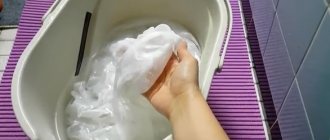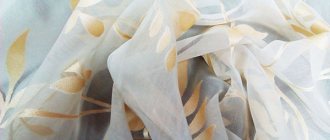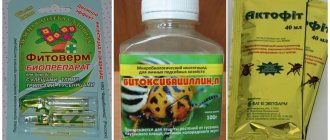Features of the material
Organza is often used for sewing curtains and drapes. This is a thin, rigid fabric made of polyester, viscose or silk. Modern technologies make it possible to make edges on tightly twisted transparent threads. Due to this, the canvas sparkles and shimmers in the light.
Several types of organza are available:
- smooth;
- reaped;
- single color;
- multi-colored;
- iridescent (chameleon).
Curtains are often decorated with printed patterns, figured perforations, and embroidery. The material can have any shade or combine several colors. Additional shine is added by gold or silver plating.
Despite its thinness and airiness, the fabric is difficult to tear. Due to this, organza wears out for a long time. Improper care can damage the material: the use of aggressive substances, mechanical stress, ironing at high temperatures.
What is prohibited to use when bleaching organza
Improper bleaching can irreversibly damage the product.
- Organza does not tolerate high temperatures. It cannot be washed at temperatures above 40 degrees, otherwise the material will become deformed.
- It is not advisable to use chlorine bleaches as they damage the fabric structure.
Before bleaching a curtain with chemical bleaches, you should study the information on the label. If it states that the product is suitable for organza, you can use it.
How to bleach organza
Whiten organza at home using ready-made bleaches or traditional methods. In order not to spoil the item, follow the rules:
- bleach by hand or on delicate mode;
- remove stains without rubbing, do not use brushes;
- bleach and rinse in cold water (35–40 °C);
- do not twist, do not use the spin program.
Before bleaching, inspect the tulle and mark dirty areas. Treat them locally with stain remover. To clean the curtain from dust, first soak it in water with washing powder. After that, bleach in a convenient way.
Oxygen bleach
Soaking with bleach is one of the easiest and fastest ways to bleach a curtain. Read the ingredients carefully before purchasing. It should not contain reflectors or chlorine. The only active substance is oxygen. It will gently bleach delicate fabrics without damaging the fibers.
Follow the instructions on the label exactly. Try not to let the concentrated liquid come into direct contact with the fabric (dilute with water).
Salt
Bleach tulle with a salt solution:
- Dissolve three tablespoons of salt in 10 liters of water.
- Add liquid powder or dish gel.
- Leave for 6-8 hours and then rinse.
Salt will remove dust and bleach, and the powder will dissolve dirt. The method is suitable for bleaching white and colored materials.
Laundry soap
The basis of a bar of laundry soap is alkali. It removes the gray color from any fabric. Whiten in two ways:
- Gently rub the stains with a damp bar, leave for half an hour and wash the organza as usual.
- Grate the soap, dilute with water to form a paste and use as liquid laundry detergent.
It is not recommended to put soap shavings into the washing machine. The soap is poorly washed out and remains on the hoses.
Hydrogen peroxide and ammonia
These homemade bleaches are suitable for any fabrics, including synthetics. The combination of hydrogen peroxide and ammonia during the soaking process gets rid of yellowness. How to whiten:
- Pour a tablespoon of ammonia into five liters of water.
- Add two tablespoons of peroxide.
- Immerse the curtain in the solution.
- Leave for half an hour and rinse.
Soda
Another substance that will rid organza of grayness. To bleach tulle, dissolve a tablespoon of baking soda in five liters of soap solution. Immerse the curtain and let it sit for two to three hours. All that remains is to rinse.
Features of caring for organza
Organza holds its shape well and is a durable material. It can be bleached at home quickly from a yellow or gray tint without fear of spoiling it. When whitening, it is important to carefully follow the instructions, especially if chemicals are used.
The fabric can last for many years, but for this it must be properly cared for. Basic moments:
- wash at a temperature not exceeding 40 degrees;
- When washing in a machine, the product is wrapped in a linen bag;
- After washing, the fabric should not be twisted;
- dry flat, avoiding direct exposure to the sun.
Even with proper care, the product will need to be bleached periodically. Tulle darkens, especially curtains, from dust, cigarette smoke, and kitchen soot. Things get dirty if there are small children or animals at home.
View this publication on Instagram
Publication from Curtains / Curtains / Kharkov (@1.gardinyshtory) February 7, 2020 at 9:09 PST
What is not recommended for bleaching organza?
It is not recommended to bleach organza curtains and tulle with aggressive chemicals. Chlorine is only for white cotton or linen. Thin fabrics from “Whiteness” or other chlorine-containing products are deformed, increasing the risk of rupture.
Bleaching agents are contraindicated for dyed materials. After use, whitish streaks will remain on the curtain. Colored tulle will refresh stain removers and detergents for delicate items.
Abrasives have a bad effect on fine matter. The granules scratch the fibers and wash away printed designs. Therefore, replace powders with gels.
How to bleach organza items in the washing machine
You can bleach the fabric in a washing machine. To do this, the item is moistened, and 10 tablets of hydroperite are placed in the powder compartment. Set to delicate wash cycle at 40 degrees, no spin. To prevent the fabric from tearing, it must be placed in a linen bag.
Organza is a durable fabric. It can be washed often without fear of damage. But it quickly becomes contaminated, acquiring a gray or yellowish tint. But bleaching fabric is quite difficult. Therefore, it is better to wash more often than to try to return the original white color later.
To see how to wash fabric:
How do you bleach organza - with special bleaches or improvised means? Share your stories in the comments, and don’t forget to tell your friends on social networks about the article.
Rules for drying and ironing
Organza practically does not wrinkle. At the same time, it melts easily under the iron. After washing, it is not necessary to iron the curtains; just hang them on the curtains. Under its own weight, the material will straighten out on its own.
If after bleaching there are still creases left, iron the curtain on the “unit” through gauze. Try not to keep the iron in one place for a long time.
When choosing an effective whitening method, consider the structure of the tulle. Thin synthetic curtains will not survive exposure to strong chemicals. Do not use any chosen product in concentrated form, but dilute it with water.
A little about organza
Organza is a fabric that is created from silk, viscose and polyester.
Thanks to this, a tough and strong fabric was created that is pleasant to the touch and almost weightless. It was created in China and was brought to Europe at the end of the 18th century. This fabric quickly became popular, despite the fact that it was very expensive. Today organza is also very popular, but more accessible.
This fabric is mainly used for:
- Sewing wedding and evening dresses;
- Sewing curtains and tulle;
- Sewing decorations for banquet halls and gift packaging;
- Handicrafts.
The use of organza in these areas is due to the fact that this fabric has the following properties:
- It is indestructible;
- It has very high light transmittance;
- Very durable;
- Resistant to organic solvents;
- Retains its original shape for a long time. Organza retains its shape and size throughout its entire service life, but it will change if you wash it incorrectly (wash at high temperature, wring out) and dry the item;
- It is durable and with proper care, it will retain its original appearance for a long time.
Thanks to this, organza products are very popular, and they are found in almost every home. However, many women do not care for the fabric correctly, which is why it quickly loses its beautiful appearance and darkens.
Whitening Recommendations
Do not use ammonia or hydrogen peroxide for bleaching as they are not suitable for synthetics and delicate fabrics. In this case, you need to use hot water with a temperature of 60 degrees, which is unacceptable for such materials. When washed this way, they become deformed, shrink and lose their attractive appearance. Hydrogen peroxide and ammonia are used for natural fabrics. They can bleach linen and cotton.
Use bleach with caution. Choose oxygen-containing compounds, as they have a gentle and gentle effect. At the same time, they wash quickly and efficiently. Do not wash organza using chlorine bleaches!
Do any whitening procedures in water with a temperature of up to 35 degrees. To keep the fabric white and fresh for a long time and acquire a beautiful shine, when rinsing, add two teaspoons of table vinegar per liter of water. After bleaching, do not iron the organza, but let the material dry and smooth out under natural conditions!
Do not twist or wring the organza too much. Be sure to read the label and follow the recommendations. It is important to wash, iron and dry your organza correctly to keep it white.
What improvised means can be used to whiten organza products?
A good way to clean organza is not only the powder or bleach suggested by the sales consultant. The means at hand, which can be found in every home, have proven themselves quite well. Let's look at the most popular and effective ones.
Laundry soap
This is a rather labor-intensive but effective method. You need to grind a bar of soap and dilute it with water, bring the solution to a boil, remove from the stove, and cool. Next, add a little clean water and soak the tulle for 12 hours. Leading step: rinse and dry the product.
Ammonia and hydrogen peroxide
We have already reviewed this option as the fastest and most effective when whitening white organza.
It should be repeated that you need 1 part of ammonia, and 2 parts of hydrogen peroxide. Follow the recipe exactly, and your tulle will shine like new.
Are whiteness and modern bleaches effective?
To achieve crystal whiteness, you can use household chemicals. Important! Do not bleach tulle with chlorine-containing products!
Whiteness contains 95% chlorine. Under its aggressive action, the structure of the material may collapse, the fabric will turn yellow, fade, and will no longer be suitable for use. Therefore, such bleach cannot be used!
Oxygen bleaches. They are produced in the form of powder or liquid gel. The components of such products decompose in water into hydrogen peroxide and soda, and oxygen is also released, which will help in the fight against yellowness, stains and odors.
Benefits of oxygen-containing products:
- they can be used for white and colored tulle, also for synthetics;
- have an antibacterial effect;
- bleach in cold and cool water;
- no need for soaking or boiling;
- with slight contamination of the material, effective with 100% bleaching when washing in an automatic machine;
- do not change the structure of the material;
- facilitate the whitening process.
By following the tips and recommendations on how to remove gray tulle at home, you can return the tulle material to its original whiteness. This will not require large financial expenditures, and the result will be obvious.
Video
If you want to visually study the bleaching process, then you should watch this video: The washing methods described in the article will help, first of all, novice housewives to eliminate various stains without causing harm to the fabric itself. Following these recommendations, you can safely wash organza by hand or in an automatic machine. In this case, nothing bad will happen to the fabric, and the dirt will be washed off. These recommendations will help not only significantly extend the life of your favorite things, but also significantly save the family budget from unplanned expenses.
Washing yellowed tulle
To bleach yellowed tulle it is not necessary to use expensive products; you can get rid of yellowness at home using available substances.
If your curtains are made of organza and nylon, then:
- Soak it in warm water, adding soap or detergent, or place the product in an automatic machine and wash it in the appropriate mode.
- While the product is being washed, prepare a solution of soda, salt or brilliant green. Dissolve soda or salt in the amount of a tablespoon in 10 liters of warm water.
- When using brilliant green, be careful to follow the recommended proportions and soaking time so as not to spoil the product. To make yellowed tulle regain its former whiteness, dilute 10–15 drops of brilliant green in 8–10 liters of warm water and mix the solution thoroughly. Immerse the curtain in it, and after 1.5–2 hours, remove it and rinse it manually, or place it in the machine on the rinsing mode.










